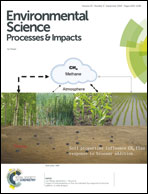Charge-assisted hydrogen bonding as a cohesive force in soil organic matter: water solubility enhancement by addition of simple carboxylic acids
Abstract
Weak bonds between molecular segments and between separate molecules of natural organic matter (OM) govern OM solubility, adsorption, supramolecular association in solution, and complexation with metal ions and oxides. We tested the hypothesis that especially strong hydrogen bonds, known as (negative) charge-assisted hydrogen bonds, (−)CAHB, contribute significantly to OM cohesion and play a role in the water solubility of solid-phase OM. The (−)CAHB, exemplified by structures such as (–CO2⋯H⋯O2C–)− and (–CO2⋯H⋯O–)−, may form between weak acids with similar proton affinity, and is shorter, more covalent, and much stronger than ordinary hydrogen bonds. Using a high-organic reference soil, we show that (−)CAHBs within the solid OM phase (intra-OM) are disrupted by solutions of aliphatic and aromatic acids, resulting in enhanced solubility of OM. The aromatic acids included naturally occurring plant exudate compounds. At constant pH and ionic strength, OM solubility increased with added organic acid concentration and molecular weight. Polar compounds incapable of forming (−)CAHBs, such as alkanols, acetonitrile, and dimethyl sulfoxide, were ineffective. Solubility enhancement showed behavior consistent with (−)CAHB theory and published observations-namely, (i) that formate is more effective than acetate due to its tendency to form stronger (−)CAHBs; (ii) that solubility enhancement peaks at pH ∼5–6, where the product of the concentration of the interacting carboxylate ions reaches a maximum; and (iii) that elution of acetate or formate through soil columns releases hydroxide ion, consistent with formation of (−)CAHBs between added acid and free weak acid groups on the solid OM. The results support the hypothesis that the (−)CAHB contributes to the cohesion of OM in the solid state.



 Please wait while we load your content...
Please wait while we load your content...